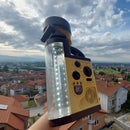Introduction: Welders Chipping Hammer - Basic Welding Project
I've recently started learning how to stick weld and during some of my early projects I did not have a suitable hammer to use for removing the slag.
So I decided to build one as a beginner project and show you how it is done.
The hammer is made from regular construction rebar pieces that I had laying around. For the handle, I've used one from a broken hammer.
The entire project is quick to make and I did mine in just an afternoon
Supplies
Old handle
Rebar pieces
Arc Welder - http://s.click.aliexpress.com/e/_rRNeuf
Welding mask - http://s.click.aliexpress.com/e/_skpTUj
Angle Grinder - http://s.click.aliexpress.com/e/_sru9B5
Cutting Disks - http://s.click.aliexpress.com/e/_sKSUcF
Sanding Disks - http://s.click.aliexpress.com/e/_s9J9e3
Rotary Wire Brush - http://s.click.aliexpress.com/e/_siiNlh
Battery Drill - http://s.click.aliexpress.com/e/_s6Hu87
Corded Drill - http://s.click.aliexpress.com/e/_sh47jH
Step 1: Gather and Clean the Parts
The parts for the hammer are just two pieces of 12mm construction rebar that I had in my scraps bucket.
The handle is from an old construction hammer that broke so I will give it a second life here.
To clean up the rebar from rust, I've put my drill into the holder and put the entire thing horizontal. Then I mounted a wire brush into the chuck and that kinda converted the drill into a benchtop grinder.
To prevent it from moving, you can add some weight on top of it or as I later did, you can use a vise to hold one side of the drill guide into it.
With enough scraping from the wire brush, the rebar will start to shine as if it just came out of the factory.
Step 2: Fabricate the Hammerhead
The hammerhead is made out of the same 12mm rebar. Ideally, you will want to use a bigger piece for it to add some weight but this is just enough as the hammer will not hit with a lot of force.
The head is 15cm long so I first cut an appropriate piece out of the rebar and put it into the vise so the factory-made line is directly on the top to use it as a reference. I then cut two angled pieces, one from each side of the line in order to get the hammerhead to be as a flat head screwdriver on one side.
On the other side, I did 4 such cuts but on a much steeper angle to get sort of a pyramid shape.
From all of the cutting, the head gets quite hot, so I periodically used some water to cool it off. I don't really know if this does anything to harden the steel but it is really not necessary to be hardened.
If you can and you know how there is nothing wrong in making it hardened.
Step 3: Sharpen the Hammer Head
On the side with the cut pyramid, we ultimately want to have a cone so we need to sharpen it.
To do that, I've attached my angle grinder with a clamp onto my workbench and I've put the hammer head into my hand drill. This way, I can rotate the head while the angle grinder is spinning in order to get a nice and even sharpened cone.
Step 4: Weld the Handle to the Hammer Head
Since this is a welding project, we need to weld the head to the handle at 90 degrees.
I did this by just holding the head by hand for the first weld, while the handle was into the vise. Once it was staying on its own, I went and weld it all around so we can have a nice and firm connection.
If you have, you can use some magnets to hold the pieces but even if you make a mistake with the initial angle, you can always make adjustments after the first weld.
Step 5: Prepare and Mount the Handle
To prepare the handle, I first cut the excess pieces that were sticking out of it from the original hammer and then I've placed it into my vise and put it on the ground.
The inside of the handle was filled with some sort of resin-like material with a lot of fibers that were really hard, so I wanted to reuse them to hold my hammer.
I used my hammer drill, to make a 12mm hole through the handle and this worked perfectly. The drilling through the resin inside the handle was almost as if I was drilling through concrete.
Before installing the handle on the hammer, I wanted to add some glue inside but the fit ended up so tight that I realized there was no need for that. If it gets loose in the future, I can always glue it up later.
Step 6: Final Cleanup
With the handle in place, I did one final round of cleaning with the wire brush, but this time, I had the hammer into the vise and the wire brush into my hand drill.
This allowed me to get into all of the grooves on the rebar and the welds to make them as shiny as possible.
Since this is just a tool that will be tossed around, there is no need of going crazy with the polishing but feel free to do it as you like.
Step 7: Rust Prevention
As a final measure before declaring the hammer as done, I sprayed it with WD-40 in order to coat it with a layer of oil.
This will repel water from the hammer and will prevent it from rusting in the future. After some time, I will wipe it again with some clean oil and this should keep it rust-free for years.
I hope that you liked this project and that you will give it a go in your workshop. For more other projects and videos, please subscribe to my YouTube channel or check out some of my other Instructables.
Thank you for reading and I'll see you in the next one.











